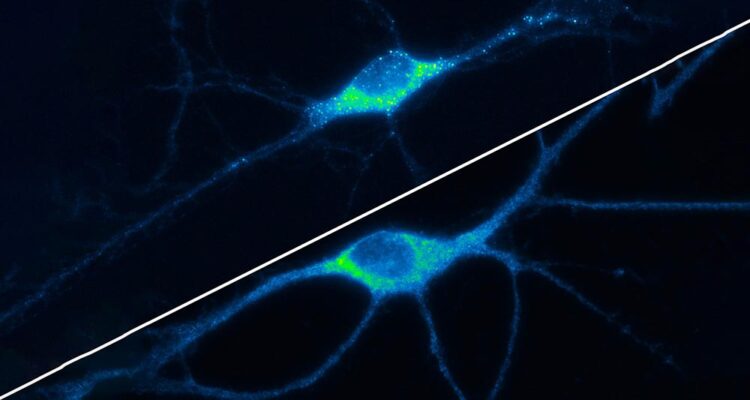Neurons: How RNA granules grow and shrink

Protein DDX6 in a neuron
© K. Bauer/LMU
LMU scientists have shown that small aggregates function as temporary RNA repositories, which are regulated by neural activity.
Cells constantly have to adapt the level of activity of certain genes to specific requirements. This applies particularly to neurons, where synapses have to be repeatedly re-formed, re-wired, and restructured. For these processes – without which learning and remembering, for example, would not be possible – messenger molecules (mRNAs) deliver protein blueprints to the right place at the right time.
In regulating these complex processes, so-called RNA granules – small aggregates of various RNA binding proteins and mRNA – play an important role. In a paper just published in the journal Nature Communications, a team led by LMU cell biologist Prof. Michael Kiebler details how certain RNA granules change depending on neural activity.
The researchers investigated granules containing the RNA binding protein DDX6. It was already known that this protein is an essential component of the granules and that it can regulate translation – that is to say, the conversion of genetic information into proteins. “We used DDX as a marker to investigate the regulation of these granules under physiological conditions in neurons,” says Karl Bauer, lead author of the study.
The researchers were able to demonstrate both in cell cultures and in an animal model that the size of these granules diminishes while the neuron matures, but that their number increases. “This suggests that the granules dissolve and that their components are redistributed in the cell,” says Bauer. “In an independent study (back to back in the same issue), our cooperation partner in Nice, led by Prof. Florence Besse, managed to demonstrate that these RNA granules take on important roles in the further life of an organism, all the way through to physiological aging.”
DDX6-RNA granules function as temporary “RNA repositories”
As neurons mature, their synaptic activity increases exponentially. This being so, the researchers suspected that there was a correlation between neural activity and the size of the RNA granules. Further experiments confirmed this hypothesis: When the cells were stimulated, the granules shrank; and when synaptic activity was curbed, they got bigger again.
In addition, the scientists discovered that a further RNA binding protein – Staufen2 – also plays a role in the formation of the granules: Without Staufen2, which is involved in mRNA transport in the cell among other functions, the granules did not grow again even when synaptic activity was suppressed. Furthermore, the supply of RNA to the granules was also necessary for growth to take place even when activity was curbed.
Taking all this evidence together, the scientists conclude from their results that DDX6-RNA granules function as temporary “RNA repositories” and are involved in the regulation of neural activity: Specific mRNAs might be brought to the granules by Staufen2 and kept there in an inactive state until they are released when needed.
The authors expect that mRNAs are also regulated in other cell types by the formation of granules. As such, the results obtained here will make a long-term contribution to a first mechanistic understanding of how cells respond to external and internal influences by temporally and spatially regulating mRNAs and their translations.
Journal: Nature Communications
DOI: 10.1038/s41467-022-30067-3
Article Title: RNA supply drives physiological granule assembly in neurons
Article Publication Date: 19-May-2022
All latest news from the category: Life Sciences and Chemistry
Articles and reports from the Life Sciences and chemistry area deal with applied and basic research into modern biology, chemistry and human medicine.
Valuable information can be found on a range of life sciences fields including bacteriology, biochemistry, bionics, bioinformatics, biophysics, biotechnology, genetics, geobotany, human biology, marine biology, microbiology, molecular biology, cellular biology, zoology, bioinorganic chemistry, microchemistry and environmental chemistry.
Newest articles

High-energy-density aqueous battery based on halogen multi-electron transfer
Traditional non-aqueous lithium-ion batteries have a high energy density, but their safety is compromised due to the flammable organic electrolytes they utilize. Aqueous batteries use water as the solvent for…

First-ever combined heart pump and pig kidney transplant
…gives new hope to patient with terminal illness. Surgeons at NYU Langone Health performed the first-ever combined mechanical heart pump and gene-edited pig kidney transplant surgery in a 54-year-old woman…

Biophysics: Testing how well biomarkers work
LMU researchers have developed a method to determine how reliably target proteins can be labeled using super-resolution fluorescence microscopy. Modern microscopy techniques make it possible to examine the inner workings…





















